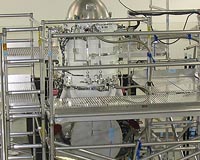 |
Pasadena CA (SPX) Nov 18, 2009 NASA's Wide-field Infrared Survey Explorer, or Wise, is chilled out, sporting a sunshade and getting ready to roll. NASA's newest spacecraft is scheduled to roll to the pad on Friday, Nov. 20, its last stop before launching into space to survey the entire sky in infrared light. Wise is scheduled to launch no earlier than 6:09 a.m. PST (9:09 a.m. EST) on Dec. 9 from Vandenberg Air Force Base in California. It will circle Earth over the poles, scanning the entire sky one-and-a-half times in nine months. The mission will uncover hidden cosmic objects, including the coolest stars, dark asteroids and the most luminous galaxies. "The eyes of Wise are a vast improvement over those of past infrared surveys," said Edward "Ned" Wright, the principal investigator for the mission at UCLA. "We will find millions of objects that have never been seen before." The mission will map the entire sky at four infrared wavelengths with sensitivity hundreds to hundreds of thousands of times greater than its predecessors, cataloging hundreds of millions of objects. The data will serve as navigation charts for other missions, pointing them to the most interesting targets. NASA's Hubble and Spitzer Space Telescopes, the European Space Agency's Herschel Space Observatory, and NASA's upcoming Sofia and James Webb Space Telescope will follow up on Wise finds. "This is an exciting time for space telescopes," said Jon Morse, NASA's Astrophysics Division director at NASA Headquarters in Washington. "Many of the telescopes will work together, each contributing different pieces to some of the most intriguing puzzles in our universe." Visible light is just one slice of the universe's electromagnetic rainbow. Infrared light, which humans can't see, has longer wavelengths and is good for seeing objects that are cold, dusty or far away. In our solar system, Wise is expected to find hundreds of thousands of cool asteroids, including hundreds that pass relatively close to Earth's path. Wise's infrared measurements will provide better estimates of asteroid sizes and compositions - important information for understanding more about potentially hazardous impacts on Earth. "With infrared, we can find the dark asteroids other surveys have missed and learn about the whole population. Are they mostly big, small, fluffy or hard?" said Peter Eisenhardt, the Wise project scientist at NASA's Jet Propulsion Laboratory in Pasadena, Calif. Wise also will find the coolest of the "failed" stars, or brown dwarfs. Scientists speculate it is possible that a cool star lurks right under our noses, closer to us than our nearest known star, Proxima Centauri, which is four light-years away. If so, Wise will easily pick up its glow. The mission also will spot dusty nests of stars and swirling planet-forming disks, and may find the most luminous galaxy in the universe. To sense the infrared glow of stars and galaxies, the Wise spacecraft cannot give off any detectable infrared light of its own. This is accomplished by chilling the telescope and detectors to ultra-cold temperatures. The coldest of Wise's detectors will operate at below 8 Kelvin, or minus 445 degrees Fahrenheit. "Wise is chilled out," said William Irace, the project manager at JPL. "We've finished freezing the hydrogen that fills two tanks surrounding the science instrument. We're ready to explore the universe in infrared." JPL manages Wise for NASA's Science Mission Directorate in Washington. The mission was competitively selected under NASA's Explorers Program managed by the Goddard Space Flight Center in Greenbelt, Md. The science instrument was built by the Space Dynamics Laboratory in Logan, Utah, and the spacecraft was built by Ball Aerospace AND Technologies Corp. in Boulder, Colo. Science operations and data processing take place at the Infrared Processing and Analysis Center at the California Institute of Technology in Pasadena. Caltech manages JPL for NASA. Share This Article With Planet Earth
Related Links Wise Astronomy News from Skynightly.com
 WISE Is Chilling Out
WISE Is Chilling OutPasadena CA (SPX) Nov 12, 2009 Engineers are busy cooling the science instrument on NASA's Wide-field Infrared Survey Explorer, or WISE. The spacecraft is scheduled to blast into space from Vandenberg Air Force Base in California on Dec. 7, 2009. It will map the entire sky in infrared light, uncovering all sorts of hidden treasures - everything from the coolest stars to dark asteroids and the most luminous galaxies. ... read more |
|
| The content herein, unless otherwise known to be public domain, are Copyright 1995-2009 - SpaceDaily. AFP and UPI Wire Stories are copyright Agence France-Presse and United Press International. ESA Portal Reports are copyright European Space Agency. All NASA sourced material is public domain. Additional copyrights may apply in whole or part to other bona fide parties. Advertising does not imply endorsement,agreement or approval of any opinions, statements or information provided by SpaceDaily on any Web page published or hosted by SpaceDaily. Privacy Statement |